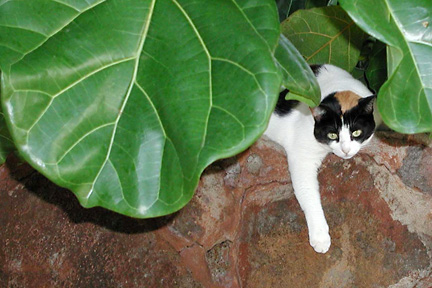
It's OK for Crystal Kim's 8-year-old cat Kiki, adopted from the humane society, to lounge in Kim's garden, but keeping neighborhood cats out takes some scare tactics. Kiki was among the pets featured in the 2004 Pets in Paradise calendar.
Various methods can
deter unwanted cats
Free-roaming cats can become unwanted and unexpected guests in your neighborhood. These could be pets allowed outdoors or even feral (un-socialized) cats. By following their natural instincts, any of these felines can act in ways that can be viewed as destructive or offensive.
Traps availableThe humane society makes humane traps available to capture cats or dogs causing problems on private property. While there is no usage fee, a refundable deposit is required for dog traps.Traps are in great demand, so it is recommended that you call before visiting the shelter to make sure one is available. Traps can be picked up at the Incoming Animals area. Call 946-2187, ext. 285.
|
"There are a number of solutions or deterrents," said the humane society's animal behavior coordinator, Marty Hutchins. "It is a matter of teaching them when and where these natural activities are appropriate and where they are not. It may require persistence but it can be done."
To discourage felines from digging up flower gardens, apply domestic cat repellents available at pet stores and garden supply stores. The Environmental Protection Agency has registered more than 30 compounds that are safe, many based on mothballs or a moth-crystal blend. Reapplication after heavy dew, rain or watering is essential to keep the scent strong. To thwart sandbox invasions, cover the play area with a large plastic or vinyl sheet when it is not in use.
"Commercial repellents can be effective deterrents but are not guaranteed to rid your yard of its nightly visitors," Hutchins said. "Alternative strategies for dealing with free-roaming cats include planting thick flowers and vegetation so close together that there is no room for cats to squeeze into. A quicker alternative: put crumpled pieces of aluminum foil in flower beds or cover the ground with medium-large stones with sharp edges. Cats dislike the feel of aluminum foil or rough stones on their paws."
CATNAPS are another natural behavior that can bother the neighbors, especially when cats choose to nap on other people's property, such as on the hoods of cars where they can scratch the paint.
Surprise devices are one way to deter cats from napping in such places. Place "scat mats" on the car fenders. Sold in pet stores, scat mats can be moved to whatever spot a cat is invading, with excellent results. When the cat jumps on the car for its daily nap, the prickly surface of the mat will drive it away again. This unanticipated and startling event can leave a negative memory that will cause it to find another place to nap.
Water also discourages most cats. When you see a cat in the garden settling down for her daily nap, use a spray bottle or garden hose to squirt it gently with water. This method can be used alone or combined with a loud noise, such as banging a stick on a metal lid, to create a bigger impact. An ambush with water accompanied by a loud noise could scare the cat away for a long time.
"Using sound or movement to discourage inappropriate behavior leaves a definite impression on cats," Hutchins said. "They seem to remember where these things happen and try to avoid experiencing it again."
Since you can't monitor your yard 24 hours a day, consider getting a motion-activated sprinkler such as the "Scarecrow." The water starts up any time a cat moves into your area, day or night.
"You may have to try several methods before finding one that works for you," Hutchins advised. "Cats are very intelligent and can usually figure out the sprinkler schedule or will avoid places until the repellent smells go away. It's best to vary the methods and strategies to keep them guessing."
Besides the physical damage a free-roaming cat can inflict on your property, a cat can cause distress in your indoor pets. A strange cat wandering in the yard, or leaving its scent, can alert your dog or cat to an intruder in their territory. Just seeing the feline through the window can taunt indoor animals. Barking or hissing from indoor pets might irritate their owners and neighbors, creating discomfort for everyone.
Until the cat can be discouraged from visiting your yard, keep the free-roaming cat out of the sight of your indoor pets. Rearrange furniture to hide the view out the window, close the curtains or move the pets to a different room to ease the stress. Distract indoor pets from activity outside by grooming or playing with them.
It is important to remember that free-roaming cats are simply acting as Mother Nature intended. They are doing things that are natural for them; the only problem is that they are doing them in inappropriate places. Use these methods to humanely discourage neighborhood cats and you'll minimize visits from these unwanted guests.
The humane society offers a booklet of tips to keep cats from wandering into your yard; it's available in the Pet Care and Advice section at www.hawaiianhumane.org or by mail. Call 946-2187, ext. 223, any time and leave your name and address on the voice mail.
[News] [Business] [Features] [Sports] [Editorial] [Do It Electric!]
[Classified Ads] [Search] [Subscribe] [Info] [Letter to Editor]
[Feedback]
